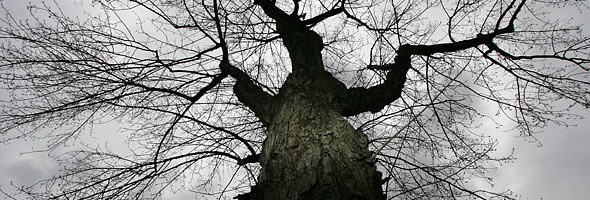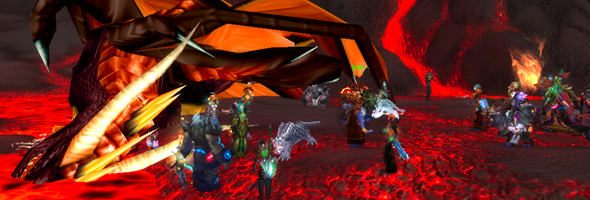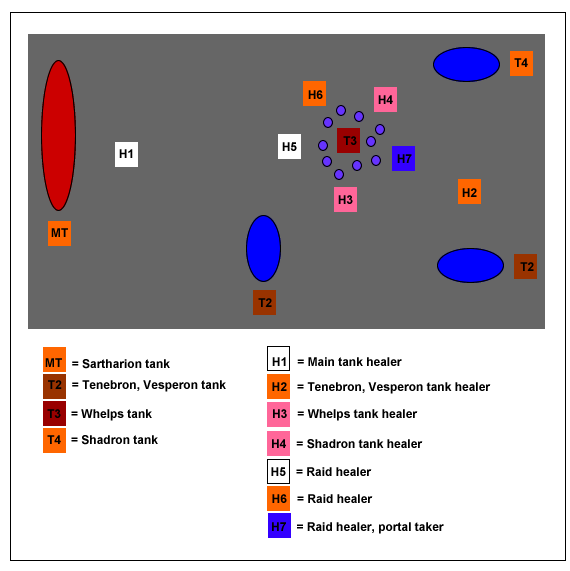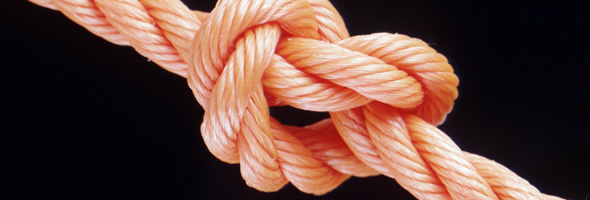
It has been a hard week to be a druid, dear friends. Not only did restoration druids miss out on any significant buffs in the most recently announced draft of class changes, but we’ve also been faced with an upcoming nerf to mana regeneration that stands to affect us more than any other class. As such, druid bloggers have taken notice; both Phaelia and Keeva have their own takes on the 3.1 changes. In this article I am going to take a look at the specifics of the changes to mana regeneration and speculate on possible ways to play around them. In case you missed the big blue letters, I’ll quote the substance of the change to mana regeneration below:
Regeneration while not casting (outside of the “five second ruleâ€Â) will be decreased. We think that (1) the ability to cast heal over time spells and then sit back and (2) benefitting from a clearcasting proc that also gets you out of the five second rule both provide too much mana regeneration, even over short time periods.
To make this change, we are reducing mana regeneration granted by Spirit across the board. However we are also boosting the effects of talents such as Meditation that increase regeneration while casting. The net result should be that your regeneration while casting will stay about the same, but your not-casting regeneration will be reduced. This change will have little impact on dps casters, since they are basically always casting.
The specific talents and abilities being boosted are: Arcane Meditation, Improved Spirit Tap, Intensity, Mage Armor, Meditation, Pyromaniac and Spirit Tap. Yes this makes these “mandatory†talents even more mandatory, if such a thing is possible.Since paladins rely less on Spirit as a mana-regeneration stat, we have to address them in other ways. We don’t want to change Illumination or Replenishment. However, we are going to increase the healing penalty on Divine Plea from 20% to 50%. Divine Plea was originally intended to help Protection and Retribution paladins stay full on mana. It should be a decision for Holy paladins, not something that is automatically used every cooldown.
In addition, we are also changing the way Spiritual Attunement works. In situations with a large amount of outgoing raid damage, as well as in PvP, this passive ability was responsible for more mana regeneration than we would like. We want to keep the necessary benefit it grants to tanking Protection paladins, while making it less powerful for Holy paladins in PvP or raid encounters with a lot of group damage.We are also taking a close look at clearcasting procs themselves. One likely outcome is to change them to an Innervate-like surge of mana so that the net benefit is the same, but healers won’t shift to out-of-casting regeneration so often.
We balance around the assumption that even 10-player groups have someone offering Replenishment. To make this even easier on players we are likely to offer this ability to additional classes, as well as make sure that existing sources of Replenishment are more equitable.
These changes are ultimately being done to bring the different healing classes more in line with each other as well as to give the encounter team more leeway when designing encounters, who can balance with these new mana regeneration numbers in mind. In a world with infinite healer mana, the only way to challenge healers is with increasingly insane amount of raid damage, so that global cooldowns become the limiting factor since mana fails to be. An example is the Eredar Twins in late Sunwell. We weren’t necessarily happy with that model, and this change hopefully allows us to move towards giving healing a more deliberate and thoughtful pace rather than frenetic spam.
So, What Does All This Mean?
For those of you who may be puzzled by Blizzard’s language, I will sum up by saying that our mana regeration, which is admittedly too high at the moment, is going to be reduced by a number of combinatory factors, including both an across-the-board nerf to Spirit and tweaks to individual spells and abilities. This is the worst kind of nerf to receive, because it will be pretty difficult to tell how each of these points affects the others without extensive testing. Here’s hoping that enough people get on the PTR to avoid major bug fixes or crippled classes. I know that I’m planning to do some PTR raiding myself to test this out. Some posters on the WoW forums and on PlusHeal are predicting that nothing will change for them, or that they won’t “feel” the changes–that’s wishful thinking, or keeping one’s head in the sand. We’re going to notice. In terms of magnitude, my guess is that this one outpaces even the great nerf to Lifebloom in patch 3.0. And we’re going to notice out of combat. Questing as a healer is about to become very, very expensive as we’ll have to sit to drink much more than formerly. As many forum posters suggested, they’re going to need to put in some bigger, faster waters.
Why So Severe?
Bornakk’s post offers some justification for the changes. He says, “When mana regeneration is trivial then certain parts of the game break down – classes that offer Replenishment are devalued, stats that offer mana regeneration are devalued, and spells that are efficient are neglected in preference to spells with high throughput.” I am sympathetic to this point. I see druids stacking Spirit over Mp5, because it’s been widely believed throughout Wrath that Mp5 is too expensive a stat in terms of item budget. I’ll also note that there’s comparatively little of it available, at least compared to the ubiquitous Spirit. More and more healers are stacking Intellect as well. There’s every reason to believe that this practice will continue, and in fact become more common. I’ve also seen many raiders glyphing Healing Touch, preferring a very fast, but not very efficient spell over the slower Nourish, which when supported by 4pc T7 becomes our most efficient tank heal. And guess what? They’ve been beating me on the meters. Evaluating spells by HPM has become a practice for theorycrafters and not players. So yes, I agree that some changes are in order. I just don’t like the direction they’ve taken.
Why Should Druids Worry?
More so even than priests, the healing druid’s fate is tied to that of Spirit. I remember when the initial changes to Spirit were put in place for 2.3. Before that time, one resto druid in each raiding guild would stack Spirit in order to sit in the tank group and give a passive buff to tanks. Like all other buff-givers in BC (ahem, shadow priests), a Spirit-stacking druid traded some of her individual power for the buff. A Spirit-stacker had to sacrifice healing throughput (+heal) and efficiency (Mp5) as a tradeoff for a high amount of Spirit. It’s hard to tell without testing it out myself on the PTR, which I certainly intend to do, but my guess is that we’re about to return to pre-2.3 regen values for Spirit–or else come very close to that number. Druids have a number of abilities and talents that depend on Spirit, most notably Innervate, Living Spirit, and Improved Tree of Life. I would also argue that Intensity is greatly dependent on Spirit. As a consequence, druid gear weights Spirit very heavily. Up until now, it has been projected that at high levels of gear, a player should strive to keep their Spirit to Intellect ratio at 1.1 to 1. This has been very easy for resto druids–in fact, we’ve risked having too much Spirit–just through picking up our tier pieces and emblem items. It is not going to be easy for us to de-emphasize Spirit. We’re going to get stuck with a certain amount of it.
If Spirit is Junk, What Can We Do?
At a certain point, we are limited by the gear available to us. Because one of our cherished techniques–rolling HoTs and then pausing to regen–is about to go the way of the dodo, we’re not going to have a lot that we can actively do during a fight to counter the nerf. The overall advice is going to be “heal less.” There’s no two ways around it–we’re not going to be able to maintain current levels of throughput or coverage in the raid. I can already run myself out of mana, and I’m usually doing so to try to be competitive on the meters. I have a good sense of how long inside the FSR spam casting can last, and even with my current mana regen, it’s only a very few minutes, possibly 6-8, but not 10. In terms of technique, we are going to be swapping glyphed Healing Touch for Nourish. We are also going to be keeping to tighter healing assignments. As S13 put it last night, “Tank healers will stay on tanks and just that.” Sniping heals will no longer be common practice, as we won’t be able to afford it. As for Innervate, which isn’t on the list for a buff and stands to be very greatly affected by the change, I’m expecting that it will still do at least a little something for us–half a mana bar maybe, as it might if you were now in greens with little to no spirit. We’ll probably be glyphing it and using it on ourselves only.
Gear and Gems
In terms of gearing and gemming, we can actually mitigate how much this nerf will hurt us. Despite the laments of many healers, Replenishment seems to be here to stay. The most persuasive argument I’ve seen for preferring this new regen mechanic to the traditional Spirit-based regen is its predictability. It’s admittedly much tidier than giving all dps casters their own native regen mechanics like healers have. To take advantage of Replenishment, we need Intellect and Intellect alone. I don’t expect healers to suddenly be able to roll on gear earmarked for DPS casters, so we will have to be creative to get around our gearing. I expect that, like Innervate, the Spirit World Glass and the Majestic Dragon Figurine will continue to have some use for regen, but the best trinkets in the new order will become, respectively, Je’Tze’s Bell and the Darkmoon Card: Greatness, Intellect version. Malygos’s heretofore lackluster Living Ice Crystals will also be worth equipping. We’ll also be putting yellow intellect gems in our gear where possible. The smartest thing to do would be to buy them now, when they might be selling low, and replace our Spirit and Spellpower gems later. As for a meta gem, we have two choices: Insightful Earthsiege Diamond and Ember Skyflare Diamond. I think the former will be more useful, but it really depends on the levels of Intellect a player is able to attain. As far as enchants go, in some cases we’re stuck with Spirit. There’s not an Intellect or Spellpower option for everything. However, I fully expect to use the Spellpower weapon enchant and Tuskarr’s Vitality for extra speed on my boots. If Spirit is giving a poor return, let’s make the tree go faster. That’s always good for hard content anyway.
Are There Good Effects to the Nerf?
I can think of one consequence of the nerf that will, in the end, favor healers. I know it seems that healing–and healing difficulty–is being made the balance point of encounters in 3.1. However, I am going to forward the radical idea that the difficulty that raiding healers currently experience will not change at all. Over time, guilds tend to take less and less healers to the same encounters. Our sphere of responsibility gets larger as the guild gets “better.” Encounters go faster with more dps, and guilds typically sit out more dps than healers on progression content. These dps want in for the farm content, and the overall load on the healers in the raid becomes greater. In fact, even in an era of enrage timers, one of the best ways to guarantee an easier time at a new encounter is to take one healer more than the most hardcore strategies suggest. I can feel the difference between 5 healer Naxx and 7 healer Naxx, both of which Conquest has done based on the players who happened to show up. I’m predicting that Ulduar is going to feel like the 5-healer Naxx–except that there will be 7-8 healers sharing this load. This change will allow a few new healers to get raid spots. Of course, the shaman (predictably) comes out looking the rosiest after the nerfs–and yes, I’m a little jealous. I’m sure that resto shamans will have many opportunities to join top-notch raiding outfits. Many guilds of all types will be looking to add a new healer to their rosters, and guilds like ours, who are actually carrying extra healers, will be able to dip into their bench. Each one of us can only do so much. We will continue, as now, to do our utmost, and no more can be asked at that point. I expect the standard number of healers for Ulduar encounters to vary between 7 and 9, as it did for most guilds in Black Temple. If Dual Specs come in, there may even be some 10 healer encounters in the future.
A Word of Encouragement
Dear friends, we have all faced the nerf bat before this moment. This current danger to our mana regeneration is in truth no greater evil than the changes to Lifebloom, which we all suffered and survived, though our tanks have taken more spike damage ever since. Some day, we will look back and remember this mana regeneration nerf, as even now we look back on the nerf to Lifebloom. Let us continue on, then, healing faithfully in raids as we always have before.




